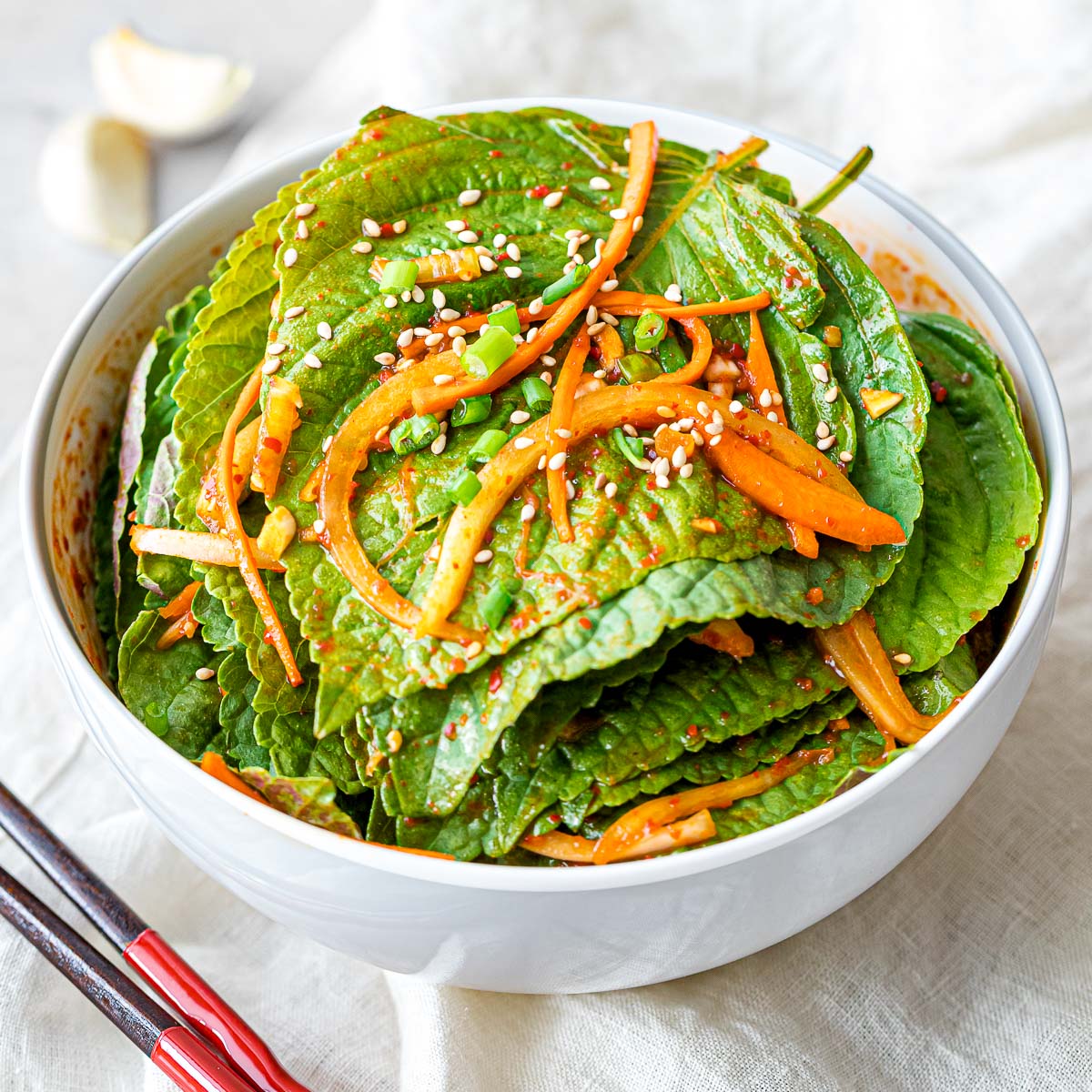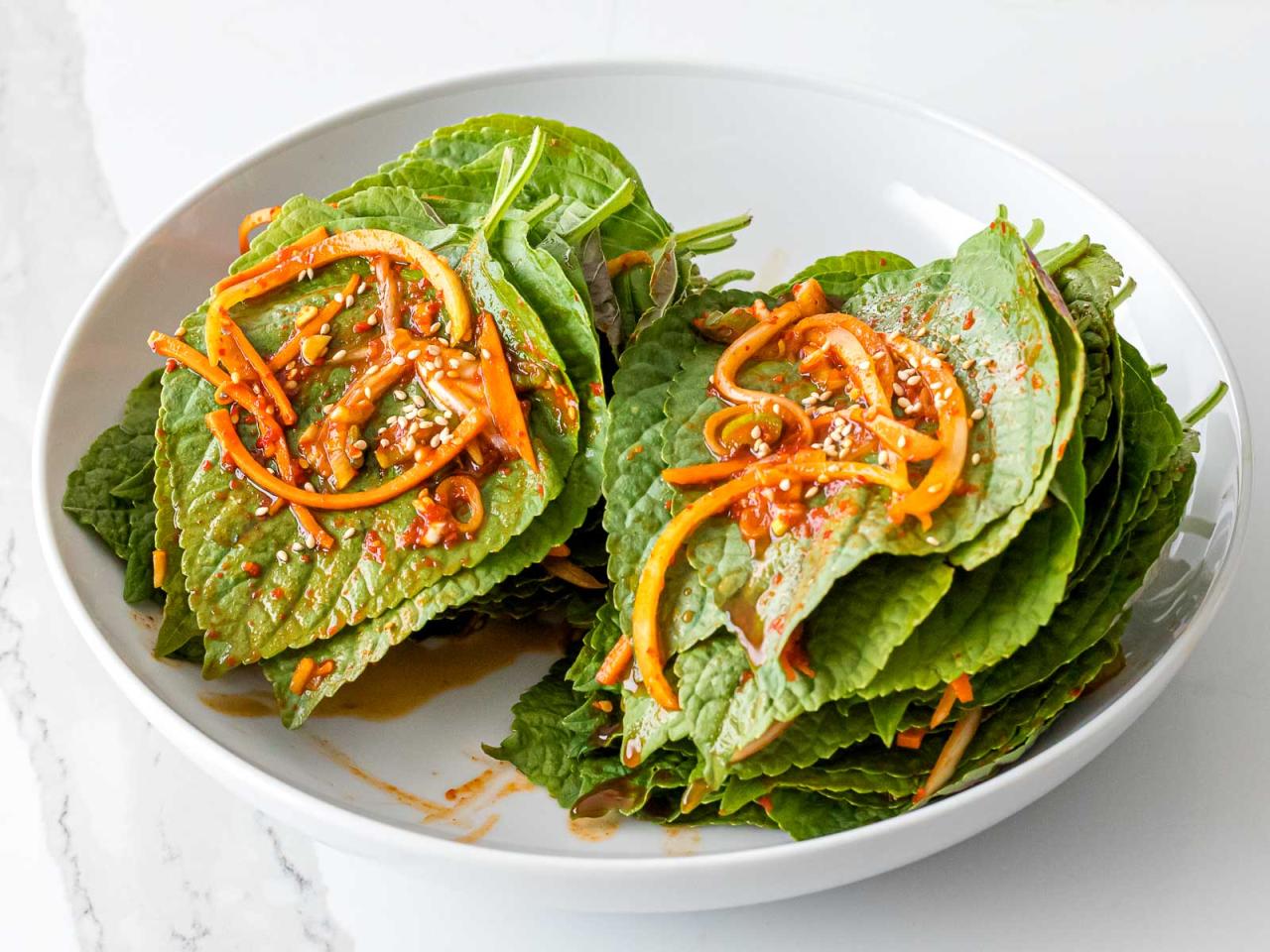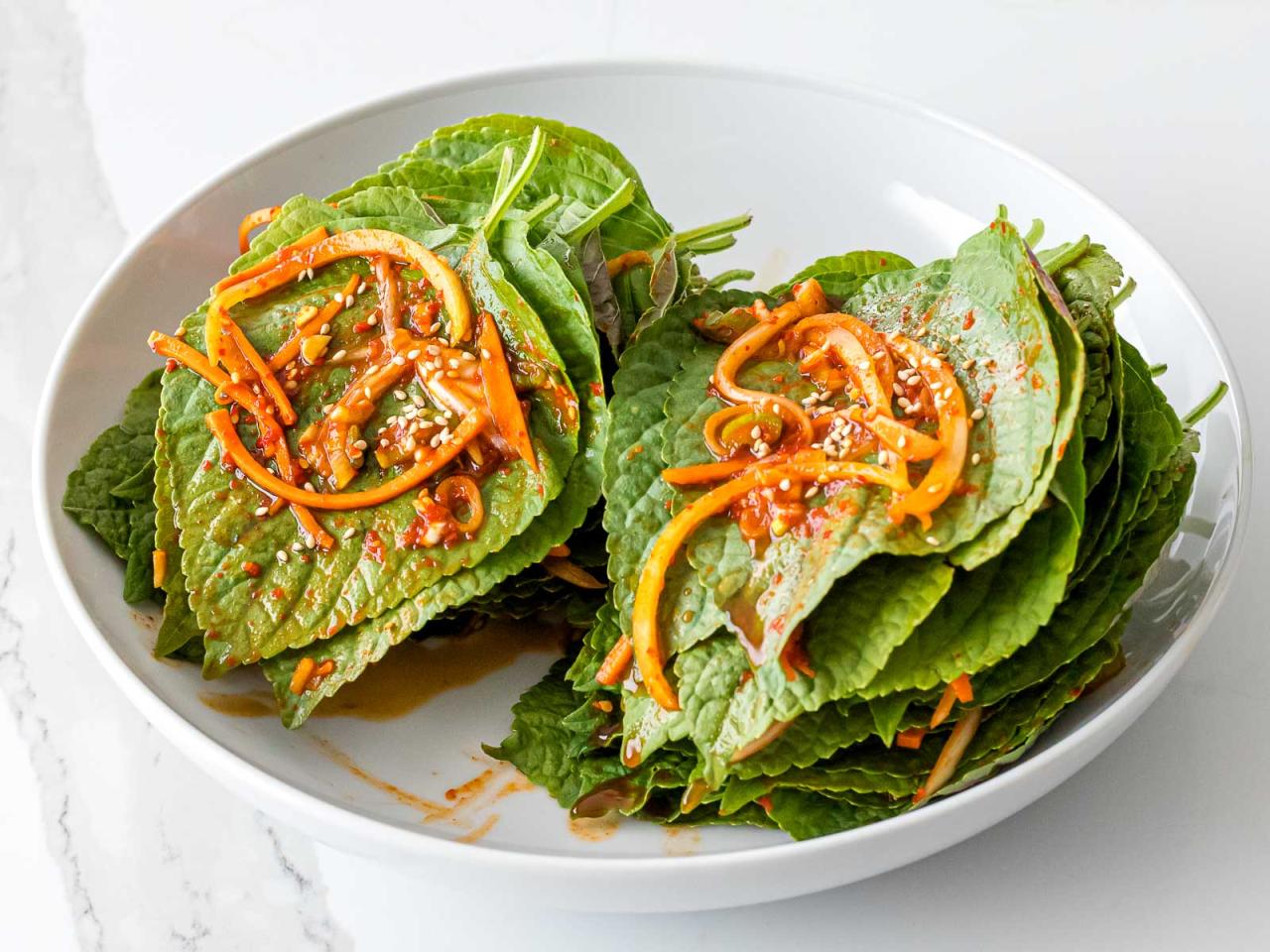Create Delicious Meals with Perilla Leaf: Tips for Flavorful and Nutritious Dishes – Perilla leaf, a vibrant green herb with a unique flavor profile, is gaining popularity in the culinary world. Beyond its captivating aroma and taste, perilla leaf offers a wealth of nutritional benefits, making it a valuable addition to any kitchen.
This versatile ingredient can be used in various cuisines, from Asian to Western, and its distinct flavor can elevate even the simplest dishes.
From its origins in East Asia to its growing presence in global kitchens, perilla leaf has a rich history and diverse applications. Its culinary versatility allows for a wide range of uses, including fresh, dried, and pickled forms, offering a spectrum of flavor profiles to explore.
This article will delve into the fascinating world of perilla leaf, exploring its flavor combinations, pairing tips, and providing delicious recipes to inspire your culinary creativity.
Introduction to Perilla Leaf
Perilla leaf, also known as shiso, is a versatile herb with a unique flavor profile that adds depth and complexity to various dishes. Its aromatic leaves, belonging to the mint family, are commonly used in Asian cuisines, particularly in Japanese, Korean, and Chinese cooking.
The flavor of perilla leaf is often described as a combination of mint, basil, and citrus, with a hint of spice. This unique blend of flavors makes it a perfect addition to a wide range of culinary creations.Beyond its culinary appeal, perilla leaf offers a wealth of nutritional benefits.
It is an excellent source of antioxidants, which help protect the body against damage caused by free radicals. Additionally, perilla leaf is rich in omega-3 fatty acids, essential for heart health and brain function. Its high vitamin A content promotes healthy vision, while its iron content supports red blood cell production.
Cultural Uses of Perilla Leaf
Perilla leaf holds a prominent place in various culinary traditions around the world.
- In Japanese cuisine, perilla leaf is widely used as a garnish, condiment, and ingredient in various dishes. It is commonly used in sushi, where it is often wrapped around the rice and fish, adding a refreshing and slightly spicy flavor.
Perilla leaf is also used in tempura, miso soup, and noodles. It is also a key ingredient in shiso-maki, a type of sushi roll where the rice is wrapped in perilla leaves instead of seaweed.
- In Korean cuisine, perilla leaf is often used as a wrap for grilled meats and vegetables, providing a unique flavor and aroma. It is also used in kimchi, a traditional fermented Korean side dish, adding a tangy and spicy flavor.
- In Chinese cuisine, perilla leaf is commonly used in stir-fries, soups, and salads. It is also used to flavor vinegarand seasoning sauces. Perilla leaf is a key ingredient in “sanbai cai,”a popular Chinese dish that features pork belly, vegetables, and perilla leaf.
- In Southeast Asian cuisines, perilla leaf is often used in curries, soups, and salads, adding a unique flavor and aroma. It is also used to flavor riceand noodles.
Culinary Uses of Perilla Leaf: Create Delicious Meals With Perilla Leaf: Tips For Flavorful And Nutritious Dishes
Perilla leaf, with its unique flavor and aroma, has been a staple in Asian cuisine for centuries. Its versatility allows it to be incorporated into a wide range of dishes, from simple salads to complex stir-fries, showcasing its distinct characteristics in various culinary preparations.
Just as you can cultivate a vibrant rose garden from cuttings, you can also expand your culinary repertoire with the versatility of perilla leaf. This aromatic herb, known for its unique flavor profile, can elevate dishes from simple to spectacular.
Learn how to cultivate a rose garden from cuttings with this guide, How To Propagate Roses From Cuttings: Your Guide to a Lush and Colorful Garden , then return to the kitchen to explore the culinary magic of perilla leaf.
Incorporating Perilla Leaf into Diverse Cuisines
Perilla leaf seamlessly integrates into different culinary traditions, adding depth and complexity to dishes.
Asian Cuisine
Perilla leaf is a cornerstone ingredient in many Asian cuisines, particularly in East Asian countries like Korea, Japan, and China.
- In Korean cuisine, perilla leaf is commonly used as a wrapping for grilled meats like bulgogi, adding a refreshing contrast to the savory flavors. It is also used in various side dishes like kimchi, providing a distinct spicy and tangy flavor profile.
- Japanese cuisine embraces perilla leaf in dishes like shiso maki, a type of sushi roll where the leaf is used as a wrapper. It is also frequently used in tempura, adding a unique flavor and aroma to the fried seafood and vegetables.
Perilla leaf, with its unique, slightly minty flavor, adds a refreshing twist to various dishes. Its versatility extends to both savory and sweet applications, making it a perfect ingredient for experimenting with new flavor profiles. For a similar aromatic experience, explore the world of kaffir lime leaves, known for their citrusy fragrance and vibrant flavor.
Kaffir Lime Leaf Recipes: Transform Your Cooking with These Delicious Ideas offers a range of inspiring recipes that showcase the versatility of this ingredient. Whether you’re adding a touch of zest to your Asian-inspired stir-fries or infusing your desserts with a citrusy aroma, both perilla and kaffir lime leaves can elevate your culinary creations to new heights.
- Chinese cuisine utilizes perilla leaf in stir-fries, soups, and sauces. Its distinct aroma and flavor enhance the taste of dishes like mapo tofu, adding a touch of complexity to the overall flavor profile.
Western Cuisine
While less common in Western cuisine, perilla leaf is gaining popularity as chefs experiment with its unique flavor profile.
- Perilla leaf can be used as a garnish for salads, adding a fresh and slightly peppery flavor to the mix. It can also be incorporated into pesto sauces, adding a unique twist to the classic Italian recipe.
- Its delicate flavor and aroma complement seafood dishes, particularly grilled fish and shellfish. It can be used as a garnish or incorporated into a marinade, adding a touch of complexity to the overall flavor.
Mediterranean Cuisine
Perilla leaf’s unique flavor profile can also enhance the richness of Mediterranean cuisine.
- Its slightly peppery flavor pairs well with grilled lamb and chicken, adding a refreshing contrast to the savory meat. It can be used as a garnish or incorporated into a marinade, adding a touch of complexity to the overall flavor.
- Perilla leaf can also be added to salads and dips, providing a unique flavor profile and adding a refreshing element to the dishes.
Methods of Using Perilla Leaf in Cooking, Create Delicious Meals with Perilla Leaf: Tips for Flavorful and Nutritious Dishes
Perilla leaf can be used in various forms, each offering unique flavor and texture characteristics.
Fresh Perilla Leaf
Fresh perilla leaf is the most common form used in cooking, offering a vibrant flavor and aroma.
- It can be used as a garnish, adding a pop of color and flavor to dishes. It can also be chopped and added to salads, stir-fries, and other dishes to enhance the overall flavor.
- Fresh perilla leaf can also be used in marinades, adding a unique flavor profile to meats and seafood. It can also be incorporated into sauces, providing a distinct flavor and aroma.
Dried Perilla Leaf
Dried perilla leaf offers a more concentrated flavor and aroma than fresh perilla leaf.
- It can be used as a seasoning, adding a distinct flavor to dishes. It can also be ground into a powder and used as a spice, adding a unique flavor profile to soups, stews, and other dishes.
Pickled Perilla Leaf
Pickled perilla leaf offers a tangy and salty flavor, adding a unique dimension to dishes.
- It can be used as a side dish or garnish, adding a refreshing contrast to savory dishes. It can also be incorporated into salads and other dishes, adding a unique flavor profile.
Flavor Combinations and Pairing Tips

Perilla leaf’s unique flavor profile lends itself to a wide range of culinary applications, allowing it to enhance and complement diverse dishes. Understanding the flavor nuances of perilla leaf and its compatibility with various ingredients can elevate your cooking to new heights.
Flavor Combinations with Perilla Leaf
The slightly minty, citrusy, and peppery notes of perilla leaf make it an ideal companion for various vegetables, proteins, and other herbs. Here is a table showcasing some complementary flavor combinations:
Ingredient |
Perilla Leaf Pairing |
Flavor Enhancement |
|---|---|---|
Vegetables |
||
Cucumbers |
Perilla Leaf, Sesame Seeds, Soy Sauce |
The minty and citrusy notes of perilla leaf enhance the refreshing taste of cucumbers, while sesame seeds and soy sauce add a savory depth. |
Tomatoes |
Perilla Leaf, Garlic, Olive Oil |
The peppery notes of perilla leaf complement the acidity of tomatoes, while garlic and olive oil add a savory and aromatic touch. |
Mushrooms |
Perilla Leaf, Ginger, Soy Sauce |
The earthy flavors of mushrooms are enhanced by the minty and citrusy notes of perilla leaf, while ginger and soy sauce provide a savory depth. |
Proteins |
||
Chicken |
Perilla Leaf, Garlic, Ginger |
The minty and citrusy notes of perilla leaf add a refreshing twist to chicken dishes, while garlic and ginger provide a savory and aromatic depth. |
Fish |
Perilla Leaf, Lemon, Chili Flakes |
The peppery notes of perilla leaf complement the delicate flavors of fish, while lemon and chili flakes add a tangy and spicy kick. |
Tofu |
Perilla Leaf, Sesame Oil, Soy Sauce |
The minty and citrusy notes of perilla leaf enhance the subtle flavors of tofu, while sesame oil and soy sauce add a savory depth. |
Herbs |
||
Basil |
Perilla Leaf, Garlic, Olive Oil |
The minty and citrusy notes of perilla leaf complement the sweet and earthy flavors of basil, while garlic and olive oil add a savory and aromatic depth. |
Cilantro |
Perilla Leaf, Lime Juice, Chili Flakes |
The minty and citrusy notes of perilla leaf complement the bright and fresh flavors of cilantro, while lime juice and chili flakes add a tangy and spicy kick. |
Perilla Leaf in Sauces, Marinades, and Dressings
Perilla leaf’s unique flavor profile makes it an excellent addition to sauces, marinades, and dressings. Its minty, citrusy, and peppery notes can add complexity and depth to various dishes.
For example, a simple marinade for chicken or tofu can be created by blending perilla leaves, soy sauce, rice vinegar, garlic, and ginger. The marinade will infuse the protein with a refreshing and savory flavor.
Another example is using perilla leaf in a dressing for salads. A simple dressing can be made by blending perilla leaves, olive oil, lemon juice, and honey. The dressing will add a unique and refreshing flavor to your salads.
Perilla Leaf in Modern Cuisine

Perilla leaf, once a staple in Asian cuisines, has experienced a surge in popularity within contemporary culinary circles. Its unique flavor profile, versatility, and nutritional benefits have captivated chefs worldwide, leading to its inclusion in innovative dishes that push the boundaries of culinary creativity.
Innovative Applications in Modern Cuisine
The use of perilla leaf in modern cuisine is not limited to traditional applications. Chefs are exploring its potential in a variety of innovative dishes, showcasing its versatility and ability to elevate the culinary experience.
- Modern Japanese Cuisine:Perilla leaf’s prominence in Japanese cuisine extends beyond traditional dishes like “shiso maki” (sushi rolls with perilla leaf). Modern Japanese chefs incorporate perilla leaf into contemporary creations like “shiso gyoza” (perilla leaf dumplings) or use its vibrant green color as a garnish for delicate sashimi plates, adding a refreshing note.
- Fusion Cuisine:Perilla leaf’s unique flavor profile makes it an ideal ingredient for fusion cuisine. Chefs have experimented with pairing perilla leaf with ingredients from other culinary traditions, resulting in innovative dishes like perilla leaf-infused pesto for pasta or perilla leaf-wrapped grilled salmon with a sweet and spicy glaze.
- Molecular Gastronomy:The versatility of perilla leaf extends to molecular gastronomy, where chefs utilize its properties to create unique culinary experiences. Perilla leaf can be incorporated into foams, gels, and emulsions, adding a complex and nuanced flavor profile to dishes.
Conclusive Thoughts
With its unique flavor, nutritional benefits, and culinary versatility, perilla leaf offers a world of culinary possibilities. From traditional Asian dishes to innovative modern cuisine, this remarkable herb adds depth and complexity to any meal. By incorporating perilla leaf into your cooking repertoire, you can unlock a new dimension of flavor and create delicious, nutritious dishes that will delight your taste buds and nourish your body.
User Queries
What is the best way to store perilla leaf?
Store fresh perilla leaf in a sealed container in the refrigerator for up to a week. For longer storage, you can freeze the leaves for up to 3 months.
Can I use perilla leaf in place of other herbs like basil or mint?
While perilla leaf shares some similarities with basil and mint, it has a distinct flavor profile. It’s best to use it as a unique ingredient rather than a direct substitute.
Where can I find perilla leaf?
Perilla leaf is becoming increasingly available in Asian markets, specialty grocery stores, and online retailers.
